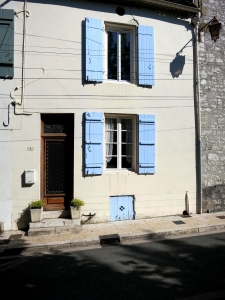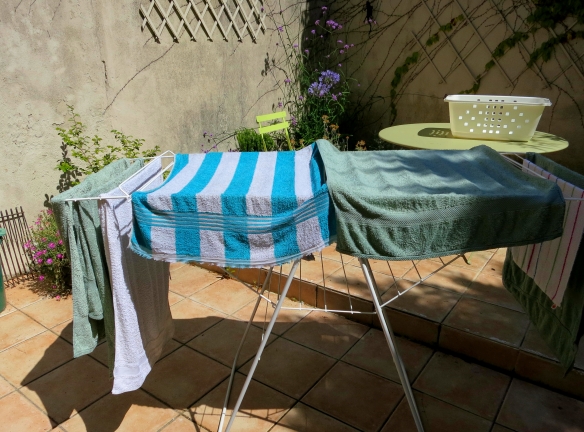 Don and I spent another pleasant morning in the garden, finishing off the weeding and continuing to reminisce. I could speak of my friendship with Ann before she met and married Don. We established that the Essex Show mentioned yesterday took place soon after he had come on the scene. The stuffed hearts caused considerable amusement. All three of us had been partial to this delicacy which is, sadly no longer available in England. We think it is probably another EU ruling which has affected UK life, preventing animal hearts from being sold in the butchers. Knowing that it was one of Ann’s favourite meals, I decided to cook her some. I used Paxo sage and onion stuffing. Bravely crunching her way through her dinner, Ann eventually, tentatively, asked: ‘How much water did you put in the stuffing?’ ‘Water?’ I said.
Don and I spent another pleasant morning in the garden, finishing off the weeding and continuing to reminisce. I could speak of my friendship with Ann before she met and married Don. We established that the Essex Show mentioned yesterday took place soon after he had come on the scene. The stuffed hearts caused considerable amusement. All three of us had been partial to this delicacy which is, sadly no longer available in England. We think it is probably another EU ruling which has affected UK life, preventing animal hearts from being sold in the butchers. Knowing that it was one of Ann’s favourite meals, I decided to cook her some. I used Paxo sage and onion stuffing. Bravely crunching her way through her dinner, Ann eventually, tentatively, asked: ‘How much water did you put in the stuffing?’ ‘Water?’ I said.
During the ‘mad cow disease’ scare in the early years of the Blair government, which resulted in large-scale slaughter of cattle which may or may not have been infected, and the horrific pyres of burning corpses which consequently littered the countryside, one of our local Newark butchers stood firm. Against emergency regulations he continued to sell exquisite beef on the bone. He even went on television to defend his stance. He had no shortage of customers and was not prosecuted.
Don’s story of a recent visit to the theatre in Bungay where the audience consisted of eight people reminded me of Charlie Chaplin. Just after the film ‘Chaplin’ came out it reached Lincolnshire. This was a biopic, starring Robert Downey Jr., brilliantly playing the acrobatic comic. Jessica and I drove out to the small town of Sleaford to see the performance. It was showing at the Odeon. Not one that has been split into several cinemas with multiple screens. One of the huge, possibly earlier music hall, establishments, which were adapted in the brief heyday of the local cinema. There was a staff of two. A very tall gentleman, who must have been in his eighties, ushered us to the ticket desk in the vast foyer, which was serviced by an equally elderly woman we presumed to be his wife. We bought our tickets and entered the auditorium. Our usher was waiting inside where he tore our tickets in half, gravely presenting us with our respective sections, whilst retaining the others. Before the show began we established that we were an audience of twelve. There was plenty of room and it was very cold. At the interval a beam lit up the ice cream girl. As you’ve probably guessed, this was our ticket seller. The ice creams were a bit hard, and, for a while, beyond the capabilities of the wooden spoons. Perhaps the vendor had mentioned the temperature to her colleague, for he came round and asked us if we would like the heating on. Naturally we all would. He disappeared, and returned with a two-bar electric fire which he placed in the centre of one of the side aisles. It was an excellent film and and a most entertaining experience. Probably a retirement project.
Watching ‘The General’, starring Jon Voigt, a black and white film about the Irish troubles, in a modern multiplex cinema in Nottingham, was actually a more difficult prospect. Throughout, we could hear an interfering, much more explosive soundtrack from the screen next door. I had to leave the cinema to ask for that to be turned down. Our watching was thereafter more pleasurable. I hoped the viewers next door appreciated their reduction in volume. This was another excellent film but, I didn’t think they’d be willing to rewind it for me, so I missed a few minutes.
 Having been unable to connect to Le Code Bar Wi-Fi from No. 6, Don suggested that I may perhaps be able to do so from the attic. Up I trotted to investigate. Actually there was one full signal, but, of course, it was a private one and I did not have the code. Undeterred, Don, tongue in cheek, suggested I might be able to get a signal from an unidentified attachment on the back wall of the house. There are two on the wall of the chateau next door. Does anyone know what it is?
Having been unable to connect to Le Code Bar Wi-Fi from No. 6, Don suggested that I may perhaps be able to do so from the attic. Up I trotted to investigate. Actually there was one full signal, but, of course, it was a private one and I did not have the code. Undeterred, Don, tongue in cheek, suggested I might be able to get a signal from an unidentified attachment on the back wall of the house. There are two on the wall of the chateau next door. Does anyone know what it is?
This evening a group of eight of us dined at Le Code Bar. There was too much material here for me to post this evening, and in any case I was busy eating duck fillet and chips followed by creme brulee, accompanied by red wine. Watch this space tomorrow.































